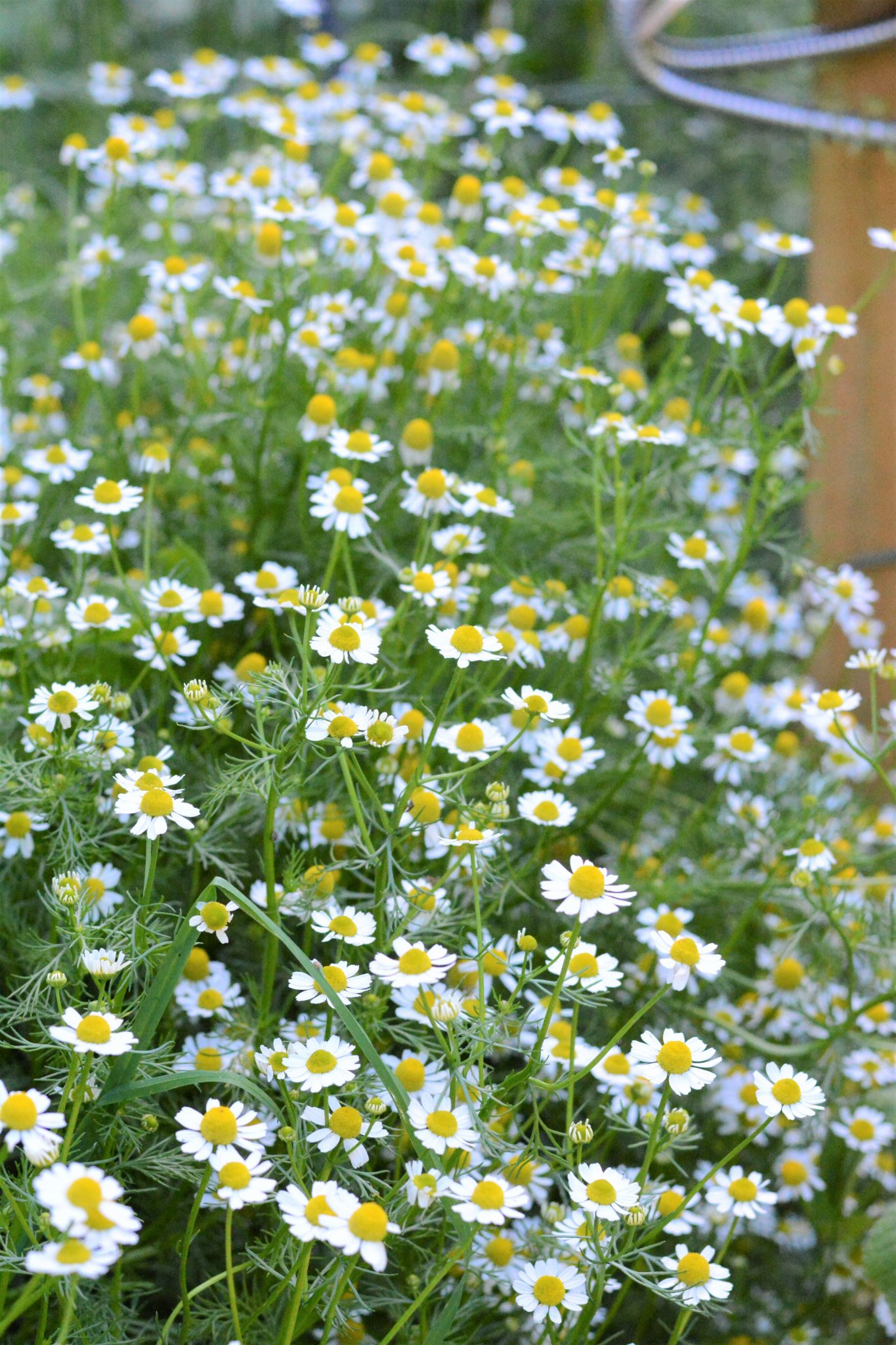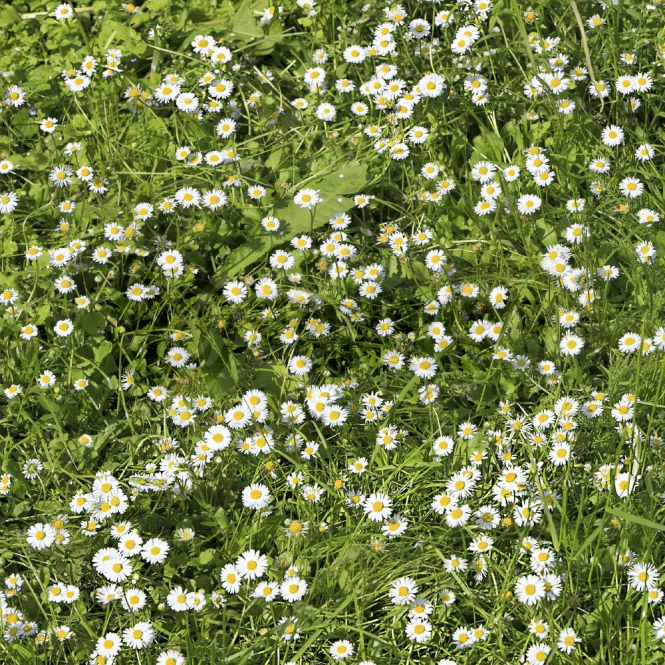Instead of the traditional grass lawn, why not surround yourself with a beautiful flowery meadow by planting a chamomile lawn? This lawn will fill your yard with daisy-like flowers in late spring and summer, creating a beautiful, fragrant, inviting lawn.
While chamomile is best known for its health and beauty benefits, it also provides an excellent ground cover. Like any other ground cover, chamomile lawn too has some pros and cons.
Chamomile lawn pros include low-maintenance, drought-tolerant, and release a pleasant aroma when stepped on. They attract beneficial insects, require minimal mowing, and can be used for herbal tea.
Chamomile lawns cons include may not withstand heavy foot traffic, require good drainage, and can be invasive in certain regions. They have lower aesthetic appeal compared to traditional lawns and may be challenging to establish from seed.
If you are looking for an out-of-the-box idea for lawn alternative, chamomile as a ground cover is worth considering. This post explores everything about a chamomile lawn to help you get started and care for such a lawn.
Is Chamomile Good for Lawn?

Yes, chamomile specifically Roman chamomile (Chamaemelum nobile) and German chamomile (Matricaria chamomilla), are often used as ground covers in lawns or as lawn alternatives due to their low-growing and aromatic nature.
Also Read:
Also, chamomile thrives in specific growing conditions (plenty of sunlight and well-draining soil), so ensure your location offers these conditions before planting. Moreover, chamomile is sensitive to extreme temperatures, so it’s not ideal for areas with harsh winters or hot summers.
A chamomile lawn saves you from constant mowing, but you’ll need to water and weed regularly to keep them healthy. As mentioned earlier, consider chamomile if you want an alternative lawn. However, look for a different ground cover for a more traditional, uniform yard.
How To Grow A Chamomile Lawn

Before establishing a chamomile lawn, you must ascertain that your yard offers the right conditions for this plant’s growth. In that case, your yard should receive full sun to partial shade and have well-draining soil. Ideally, your yard should get direct sunlight for a minimum of 6 hours every day.
Furthermore, you must pick the right time to plant chamomile. If you want to seed directly, sow the seeds in spring once the last frost disappears. On the other hand, grow chamomile indoors around six weeks before the frost’s last day if you intend to transplant the seedlings to your lawn.
Here are the steps to grow a chamomile lawn.
Step 1. Prepare The Soil
Soil preparation before planting chamomile will ensure the plants grow properly and thrive. So, begin by clearing your lawn and removing any existing grass or weeds by digging them up or using an herbicide.
After that, test your soil with a soil test kit to ensure it has a pH of between 5.5 and 7.5, which is conducive to chamomile growth.
You should also amend the soil because chamomile grows best in organic matter-rich soil. Therefore, add organic matter like leaf mold, compost, or well-rotted manure. Aim to add about 2 to 3 inches of organic matter to your lawn’s top 6 inches of soil.
After that, loosen up to 6 inches deep of the soil with a garden tiller or garden fork to help mix the ground with the organic matter, thus improving soil structure.
Also, rake your lawn to remove large rocks or debris, then smoothen the surface. Make sure you also level the soil with a rake to help the chamomile grow uniformly
Step 2. Plant the Chamomile Seeds or Seedlings
If you are planting the chamomile seeds directly into the soil, scatter them evenly over the soil. Next, gently rake them in, ensuring the seeds are covered by about ¼ inch of soil. You will need about an ounce of chamomile seeds for 1000 square feet of lawn.
On the other hand, if you are transplanting chamomile seedlings, plant them evenly, leaving a space of about 6 to 8 inches between every seedling. Keep in mind that you must acclimate the seedlings to an outdoor environment for a week before planting.
Step 3. Water Regularly
Chamomile requires regular watering to help it establish and grow. Therefore, water your new chamomile lawn lightly but consistently, ensuring the soil is moist but not drenched.
Step 4. Fertilize Sparingly
Although chamomile does not require much fertilizer to thrive, applying a bit of balanced fertilizer in the spring and midsummer will help promote healthy growth.
Step 5. Manage Weeds
You must also keep your lawn weed-free because chamomile can be susceptible to weeds. So, monitor your lawn and carefully hand-pull any weeds that appear without disturbing the chamomile plants.
Chamomile Lawn Pros And Cons
The decision to establish a chamomile lawn will depend on your preference, needs, and the availability of environmental conditions for chamomile growth. However, you must also account for the advantages and disadvantages of chamomile
Chamomile Lawn Pros
a) Low-Maintenance
Chamomile requires less fertilizing, mowing, and watering than traditional grass lawns.
b) Fragrant
Chamomile produces a pleasantly sweet, apple-like fragrance, giving your lawn a lovely aroma. The scent is released when you walk on or crush the chamomile plants.
c) Drought-Tolerant
Chamomile can withstand periods of dry weather without needing frequent watering as a traditional grass lawn.
d) Attractive to Pollinators
Chamomile attracts pollinators like butterflies, helping promote a healthy ecosystem and offering a habitat to endangered species. Also, insects, such as butterflies, enhance your yard’s beauty further.
e) Medicinal Properties
Dried chamomile flowers have flavonoids and terpenoids, which relieve inflammation and prevent diseases. Dried chamomile treats muscle spasms, hay fever, insomnia, gastrointestinal issues, ulcers, and bleeding. You can also make tea with dried or fresh chamomile flowers.
Chamomile Lawn Cons
i) Less Durable Than Grass
Chamomile is less durable compared to grass. Also, heavy foot traffic or pets can make a chamomile lawn patchy.
ii) Not Suitable For Every Lawn
You cannot grow chamomile on every lawn because it requires specific conditions. For instance, yards with poor drainage or shade are not ideal.
iii) Susceptible to Herbicides and Weeds
Weeds can overwhelm chamomile, so you must help your lawn fight these invasive plants by weeding.
iv) Slow To Establish
Establishing a Chamomile lawn requires patience because it may take a year or even longer to fill in completely.
v) Limited Use
Chamomile is best suited for ornamental purposes. Furthermore, it’s not suitable for areas that expect high foot traffic or other heavy use, so if your kids and pets regularly play on the lawn or you perform different activities there, pick a different ground cover.
How To Maintain Your Chamomile Lawn
Maintaining a chamomile lawn requires care and attention to keep it healthy and looking its best. Here’s what to do:
Water
Chamomile prefers moist but not waterlogged soil, so water your chamomile lawn regularly, especially during dry periods. Water deeply to help the roots grow deeper into the soil.
Fertilize
Use a balanced fertilizer on your chamomile lawn 1 to 2 times a year to promote healthy growth.
Mow
You can let the chamomile grow longer and trim it occasionally with scissors to keep it neat. Keep the blade at 3 inches or higher when cutting chamomile to avoid damaging the plants.
Weeding
Chamomile is vulnerable to weeds, so walk around your lawn regularly and hand-pull any weeds. Although there are multiple weed control methods, hand-pulling keeps you from damaging your chamomile plants.
Pest And Disease Control
Aphids and fungal diseases can attack your chamomile lawn, so monitor the plants for signs of pests or diseases. Eliminate pests and diseases using the appropriate organic insecticides or fungicides.
Renewal
A chamomile lawn gets patchy over time, especially parts with heavy foot traffic. Therefore, renewal is essential if you wish to keep the lawn looking its best. Do so by overseeding with new chamomile seeds or dividing and replanting existing plants.
FAQs
Is Chamomile Invasive?
Chamomile isn’t aggressive enough to be considered an invasive species but can self-seed and spread under the right conditions. The low-growing plant spreads by sending out runners or through self-seeding, forming dense foliage and flower mat.
Is Chamomile Lawn Safe For Dogs?
A chamomile lawn is safe for dogs, but they can suffer from digestive upset like vomiting and diarrhea if they consume large quantities. Also, some dogs are allergic to chamomile, causing to develop respiratory system and skin irritation.
Can You Mow Chamomile Lawn?
You can mow a chamomile lawn to keep it from overgrowing. However, do it carefully to avoid damaging the plants and avoid cutting them too short since it damages the stems and roots, killing the plants. Leaving your chamomile lawn unmowed allows it to form a dense mat of flowers and foliage.
Can You Walk On A Chamomile Lawn?
You can walk on a chamomile lawn because it can handle light traffic. However, subjecting it to regular stress from walking on it will flatten and damage it.
Final Remarks
Establishing a chamomile lawn not only gives you an eye-catching fragrant carpet but also healing properties. The scent produced from walking on chamomile can help soothe your mind and body. Moreover, making herbal remedies and tea from chamomile flowers is easier when you have a yard full of them.

Hey there, I’m Derek Schew, a writer for Lawnholic.com, where we cover everything and anything related to lawns. As someone who’s spent countless hours tending to my own lawn, I’m passionate about sharing my knowledge and helping others achieve the perfect yard. From lawn care tips to product reviews, I’m committed to providing our readers with the most accurate and up-to-date information available. So whether you’re a seasoned lawn enthusiast or just getting started, I invite you to join our community and discover the joys of a lush, green lawn.
